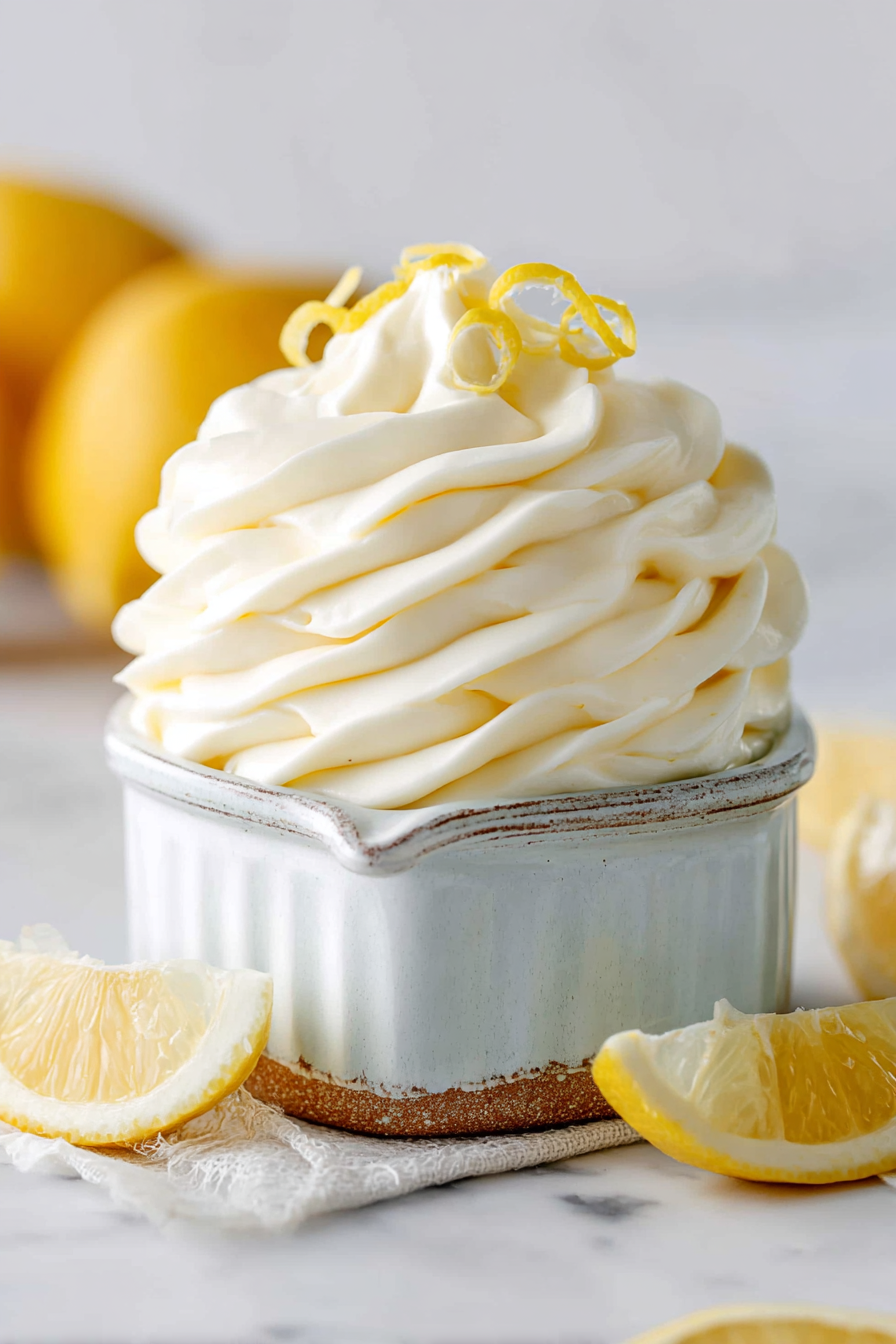Delish Lemon Ermine Frosting Recipes

This frosting is a vintage-style, silky lemon ermine that gets its lift from a cooked flour-and-milk base rather than heaps of powdered sugar—light, creamy, and delicately lemony without being cloying. It’s the kind of frosting that tastes old-fashioned but feels fresh: smooth, slightly cloud-like, and perfect for layered cakes, cupcakes, or simply a sweet smear on a warm lemon loaf.
My husband calls this “the frosting that makes everything celebratory,” and honestly, he’s right. I first made it for his birthday when I wanted something less sweet than traditional buttercream but still substantial enough to hold up between cake layers. Our kids kept sneaking spoons from the mixing bowl, and now whenever I say I’m making a lemon cake, they appear like magic to help taste-test. It’s become our go-to when we want a dessert that’s a little refined but still homey—perfect for Sunday tea or a birthday where you want everyone to be a little impressed with almost no fuss.
Why You’ll Love This Delish Lemon Ermine Frosting Recipes
– It’s light and silky, not grainy or overly sweet, so the lemon flavor shines through without being masked by sugar.
– The cooked flour method creates a stable frosting that holds shape for decorating yet stays tender and spreadable.
– Because it uses real lemon zest and juice (not just extract), it has a bright, fresh citrus tang that feels seasonal and sophisticated.
– It pairs beautifully with simple cakes—vanilla, almond, or a tender lemon cake—so you don’t need an elaborate recipe to make an elegant dessert.
Behind the Recipe
This frosting is one of those techniques that rewards patience: you start by cooking a mixture of flour and milk into a thick, roux-like paste, chill it until cool, then whip it bright and airy with softened butter and lemon. The trick is texture—if the base is smooth and fully cooled, it transforms into a pillow-y frosting; if it’s lumpy or still warm, the butter won’t incorporate properly. I learned early on to cool the cooked base completely (spreading it thin in a shallow bowl helps), and to use room-temperature butter so the final whip is glossy and smooth. A microplane for zest and a fine sieve for strained juice can make a surprisingly big difference in clarity of flavor and mouthfeel.
Shopping Tips
– Baking Basics: Use all-purpose flour for the cooked base; it thickens reliably and gives the right texture—avoid self-rising or cake flour here.
– Dairy: Choose whole milk for richness; skim will work but the frosting will be noticeably less silky.
– Fats & Oils: Use unsalted butter so you can control the seasoning; if using salted, reduce or skip any added salt.
– Citrus: Pick firm, glossy lemons with fragrant skin for zest; Meyer lemons are lovely if you want a sweeter, floral note.
Prep Ahead Ideas
– Make the cooked flour-and-milk base a day in advance and chill it overnight; it keeps well and actually whips up better when fully cold.
– Zest and juice the lemons a day ahead and store zest in a small airtight container and juice in the fridge in a sealed jar.
– Keep room-temperature butter measured and ready in a covered bowl if you plan to assemble the frosting quickly—this saves time getting the texture right during whipping.
Time-Saving Tricks
– Cook the base in a wide, heavy-bottomed saucepan so it thickens faster and you spend less time stirring.
– Use a stand mixer with the paddle attachment to get a smooth, aerated frosting faster than by hand.
– Prep mise en place for zest, juice, and butter before you start whipping—once you begin, things happen quickly.
Common Mistakes
– Overheating the cooked base: if it scorches or turns too dark, you’ll get a toasty flavor and uneven texture—watch the heat and stir constantly once it starts to thicken.
– Trying to whip while the base is warm: I did this once and the butter collapsed; always cool the base completely first.
– Using cold butter: it won’t incorporate smoothly, and you’ll end up with lumps—bring butter to room temperature but don’t make it greasy or melty.
– Fix: If your frosting is too loose, chill it briefly and then re-whip; if it’s grainy, try smoothing it through a fine sieve and whipping longer.
What to Serve It With
This frosting is classic with a simple lemon or vanilla layer cake, but it’s also lovely on almond cupcakes, pound cake, or a light sponge. For contrast, pair it with a berry compote or a tart rhubarb jam between layers to add acidity and texture.
Tips & Mistakes
For smoothness, strain the cooked base before chilling if you see any lumps. If you need to hold piped edges, chill the frosted cake briefly between layers. Remember that this frosting is less sweet than American buttercream—if you prefer a sweeter profile, a small amount of sifted powdered sugar can be folded in, but add sparingly so you don’t lose the lemon’s brightness.
Storage Tips
Store in airtight containers in the fridge. It reheats beautifully, but if you sneak a bite cold straight from the container, it still works.
Variations and Substitutions
– For a brighter profile, add a splash of lemon juice to the whipped frosting, but do so sparingly to avoid thinning it; zest gives concentrated aroma without extra liquid.
– Swap part of the milk for buttermilk for a tangier undertone, but test a small batch first—acid changes how the flour thickens.
– If you need a dairy-free version, substitute a neutral, full-fat plant milk for the base and use a vegan butter that whips well; results will be slightly different in texture but still delicious.
– If you want sweeter and simpler, traditional American buttercream works as a plug-and-play alternative, but you’ll lose the airy, custardy quality that makes ermine special.

Write me the frequently asked questions and answers Delish Lemon Ermine Frosting Recipes in the same way as the example below.
Frequently Asked Questions

Delish Lemon Ermine Frosting Recipes
Ingredients
Main Ingredients
- 1 cup milk Use whole milk for the creamiest texture.
- 0.25 cup all-purpose flour Sifted for better blending.
- 1 cup unsalted butter Softened to room temperature.
- 1.5 cups granulated sugar Adjust to taste.
- 2 tablespoons lemon zest Freshly grated for vibrant flavor.
- 2 tablespoons lemon juice Freshly squeezed for best taste.
- 1 teaspoon vanilla extract Pure extract is recommended.
Instructions
Preparation Steps
- In a saucepan, combine the milk and flour. Stir over medium heat until it becomes a thick paste. Remove from heat and let it cool completely.
- In a mixing bowl, beat the softened butter and sugar together until it's creamy and fluffy.
- Once the milk mixture is cooled, blend it into the butter-sugar mixture until smooth. Then add in the lemon zest, lemon juice, and vanilla extract. Mix until everything is well combined.
- Your delicious lemon ermine frosting is now ready to spread on your favorite cakes! Enjoy the burst of citrus flavor!
